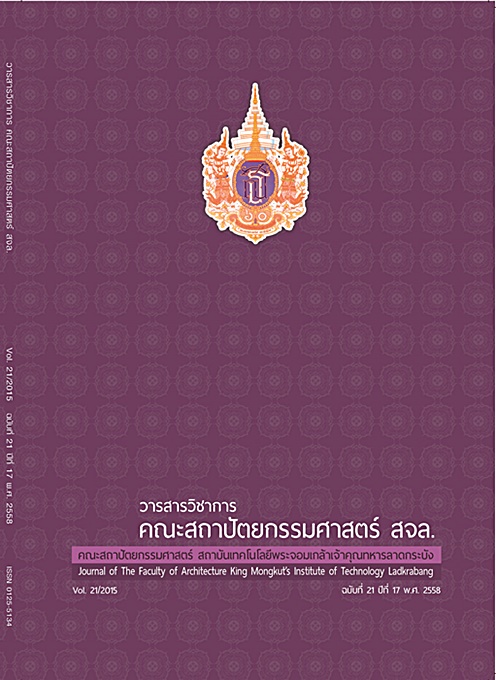การวิเคระห์ผลงานและปัจจัยที่มีผลต่อบทภาพยนตร์ไทยระดับคุณภาพช่วงปี พ.ศ. 2548-2551 (The Analysis of Qualified Thai Screenplays and Its Factors (2005-2008))
Main Article Content
บทคัดย่อ
บทคัดย่อ
การวิจัยเรื่อง “การวิเคราะห์ผลงานและปัจจัยที่มีผลต่อบทภาพยนตร์ไทยระดับคุณภาพช่วงปี พ.ศ. 2548-2551” นี้เป็นการวิจัยเชิงคุณภาพ มีวัตถุประสงค์ ดังนี้ 1. เพื่อวิเคราะห์โครงสร้างและกระบวนการเขียนบทภาพยนตร์ไทยระดับคุณภาพช่วงปี พ.ศ. 2548-2551 ไว้เป็นองค์ความรู้โดยใช้หลักการเขียนบทภาพยนตร์ 2. เพื่อสรุปปัจจัยที่มีผลต่อนักเขียนบทภาพยนตร์ไทยระดับคุณภาพในช่วงปี พ.ศ. 2548-2551 ไว้เป็นแนวทางสำหรับผู้สนใจด้านการเขียนบทภาพยนตร์โดยศึกษาโครงสร้างและกระบวนการทำงานเขียนบทภาพยนตร์บันเทิงจากการวิเคราะห์ผลงานและวิเคราะห์ปัจจัยต่างๆ ที่มีผลต่อการสร้างสรรค์ผลงานของนักเขียนบทภาพยนตร์ไทยในช่วงปี พ.ศ. 2548-2551 ซึ่งเป็นช่วงที่ค่ายผลิตภาพยนตร์ไทยเปิดโอกาสในการนำเสนอเรื่องราวสำหรับสร้างเป็นภาพยนตร์ไทยได้หลากหลายขึ้นไม่จำกัดแต่เพียงเนื้อเรื่องราวที่ตอบสนองตลาดวัยรุ่นเพียงอย่างเดียว โดยผู้วิจัยได้เลือกวิเคราะห์บทภาพยนตร์ไทยที่ได้รับรางวัลบทภาพยนตร์ยอดเยี่ยมและรางวัลภาพยนตร์ยอดเยี่ยมจากรางวัลภาพยนตร์แห่งชาติ สุพรรณหงส์ และ รางวัลภาพยนตร์ไทย ชมรมวิจารณ์บันเทิง (Bangkok Critics Assembly) จำนวน 3 เรื่อง ได้แก่ “มหา’ลัยเหมืองแร่” (พ.ศ. 2548) “เฉิ่ม” (พ.ศ. 2548) และ “รักแห่งสยาม” (พ.ศ. 2550) ซึ่งเป็นผลงานของ จิระ มะลิกุล คงเดช จาตุรันต์รัศมี และชูเกียรติ ศักดิ์วีระกุล ตามลำดับ ทั้ง 3 ท่านเป็นทั้งนักเขียน บทภาพยนตร์และผ้กำกับภาพยนตร์ที่มีผลงานโดดเด่นในช่วงปี พ.ศ. 2548-2551 ผู้วิจัยศึกษาข้อมูลพื้นฐานจากเอกสาร ตำรางานวิจัยที่เกี่ยวข้องด้านการเขียนบทภาพยนตร์ การเก็บข้อมูลโดยใช้วิธีสัมภาษณ์เชิงลึกแบบไม่มีโครงสร้าง
ผลการวิจัยพบว่าโครงสร้างและกระบวนการทำงานเขียนบทภาพยนตร์ระดับคุณภาพที่ได้รับการยอมรับจากรางวัล
ต่างๆ นั้นแม่ว่านักเขียนบทภาพยนตรทั้งสามจะใช้ประสบการณ์และความรู้สึกส่วนตัวในการสร้างสรรคผลงาน แต่โครงสร้างและกระบวนการทำงานนั้นยังสามารถเทียบเคียงกับหลักการเขียนบทภาพยนตร์และแนวคิดต่างๆ ที่ผู้วิจัยรวบรวมไว้จากเอกสารตำราของผู้เชี่ยวชาญต่างๆ อาทิ องค์ประกอบสำหรับการเริ่มต้นเขียนบทภาพยนตร์ (Premise Log Line Theme Plot Treatment) การเล่าเรื่องแบบ 3 องก์ (Three-Act Structure) การสร้างตัวละคร การสร้างความขัดแย้ง การใช้จุดพลิกผัน (Turning Point) หรือ จุดหักเห (Plot Point) การใช้จุดวิกฤติ (Crisis) และ จุดวิกฤติสูงสุด (Climax) การใช้บทสนทนา (Dialog) และบทบรรยาย (Narration) นอกจากนี้ปัจจัยที่มีผลต่อการเขียนบทภาพยนตร์ไทยระดับคุณภาพในช่วงปี พ.ศ. 2548-2551 มีผลต่อการเขียนบทภาพยนตร์ไทยระดับคุณภาพมาจากสองปัจจัยหลัก ได้แก่ 1. ปัจจัยภายใน คือ แรงบันดาลใจประสบการณ์และความรู้สึกส่วนตัวของนักเขียนบทภาพยนตร์เอง ซึ่งเป็นประโยชน์และมีประสิทธิภาพ ปรากฏในผลงานภาพยนตร์ทั้งสามเรื่องทำให้ได้รับรางวัลและมีคุณภาพ 2. ปัจจัยภายนอก คือ แหล่งทุนสนับสนุนงานสร้างภาพยนตร์หรือค่ายผลิตภาพยนตร์มักเชื่อมั่นนักเขียนบทภาพยนตร์จากบทบาทการเป็นผู้กำกับภาพยนตร์ที่มีผลงานเป็นที่ยอมรับทั้งด้านเนื้อหาและรายได้มาก่อน
ค่ายผลิตภาพยนตร์มีการจัดการด้านการตลาดและกลุ่มเป้าหมายที่คลาดเคลื่อนเป็นข้อจำกัดในการสร้างสรรค์ผลงานเนื่องจากค่ายผลิตภาพยนตร์มุ่งหวังผลกำไรมากเกินไป ปรากฏชัดในผลงานภาพยนตร์เรื่อง “เฉิ่ม” ที่ผู้ชมผิดหวังจากการประชาสัมพันธ์ภาพยนตร์แนวตลกโรแมนติก แต่ความจริงแล้วเป็นภาพยนตร์แนวชีวิตเสียดสีสังคม และปรากฏในผลงานภาพยนตร์เรื่อง“มหา’ลัยเหมืองแร่” ที่ไม่ประสบความสำเร็จด้านรายได้ แต่ได้รับรางวัลภาพยนตร์ยอดเยี่ยม
คำสำคัญ : นักเขียนบทภาพยนตร์ไทย บทภาพยนตร์ไทย หลักการเขียนบทภาพยนตร์
Abstract
The Analysis of Qualified Thai Screenplays and Its Factors (2005-2008) is a qualitative Thai film screenwriting research aiming 1. to analyze and demonstrate screenwriting principles for qualified Thai feature films during 2005-2008. and 2. to Summarize of miscellaneous factors (marketing aspects, investors, audiences, etc.) for example that may affect Thai screenwriting processes. Three awarded Thai feature films (2005-2009) from
National (Suphannahong) Film Award and Bangkok Critics Assembly Award have been selected demonstrating various story contents and different genres not focusing on meeting teenage market alone. Three screenwriters are also directors for their success feature films; “The Tin Mine” (2005) by JiraMalikul, “Midnight my Love” (2005) by Kongdej Jaturanrassamee. And “Love of Siam” (2008) by Chukiat Sakveerakul. The research data
were gathered from literature and interviews.
The results have been divided into two parts. Part I is about the analysis of screenwriting principles used in three awarded Thai feature screenplays demonstrating the basic elements of screenwriting (Premise, Log Line, Theme, Plot. and Treatment), the three-act structure, character, conflict, turning point/ plot point, crisis/climax, and dialog/narration. Information was gathered from national and international screenwriting experts.Although three screenwriters have been worked by their own skills and experience but they still used screenwriting principles. The second part is the summary of factors that influence the quality of the screenplay during 2005-2009 indicating that there are two key factors. The first factor is screenwriters’ inspiration that results to their awarded work. The second factor is Thai film studios, who support funds, usually approving funds to those who are also film directors. The marketing plan causes problem to target audiencs shown in “Midnight My Love”. A miscommunication on promotion plan made target audience disappointed, while income failed in “The Tin Mine”.
Keyword : Thai Screenwriter Thai Screenplay Screenwriting Principles
Article Details
This work is licensed under a Creative Commons Attribution-NonCommercial-ShareAlike 4.0 International License.
Copyright Transfer Statement
The copyright of this article is transferred to Journal of The Faculty of Architecture King Mongkut's Institute of Technology Ladkrabang with effect if and when the article is accepted for publication. The copyright transfer covers the exclusive right to reproduce and distribute the article, including reprints, translations, photographic reproductions, electronic form (offline, online) or any other reproductions of similar nature.
The author warrants that this contribution is original and that he/she has full power to make this grant. The author signs for and accepts responsibility for releasing this material on behalf of any and all co-authors.


